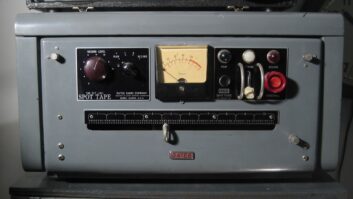Small-market radio is alive and well in upstate New York: RCN’s WUTQ, WSKS and WBUG The discussion concerning local radio ownership is one that maintains a steady murmur when it comes down to the question of how best to serve the community. Is it important?
Station owners both large and small grapple with how best to keep a watchful eye on what is relevant in their service area. Rarely does an opportunity arise from a studio relocation project that lends itself to serving the community in a unique way.

Since 1991, Roser Communications Network in Utica, N.Y., has served a sizeable geographical swath of upstate New York. After a few years of ownership gymnastics, Roser was able to drill down on developing formats for Utica and hiring plenty of staff to do so. With 21 employees working under one roof for five stations, owner and founder Ken Roser began taking steps to relocate the AC, Country and Top 40 formats into a more usable space. The Roser group was on the 15th floor of an office building in downtown Utica. As the operation grew, more space was simply a must.,
GET ME TO THE CHURCH ON TIME
In September of 2014 an attractive 10-acre piece of land situated between the Erie Canal and Mohawk River was put up for sale. It had previously been owned by a church.
Part of the 6,000-square-foot space, formerly used by a church, being made ready for RCN’s Utica stations The building itself and the 10-acre lot piqued Ken Roser’s interest for two key reasons. The 6,000-square-foot empty building could provide a veritable blank slate for potential studio and business office space.

Plus the flat 10 acres could make for endless opportunities to serve the community. Ken’s mind began racing at this point with visions of concerts and numerous other events where his radio outlets could engage with the Utica community on Roser’s own property. Foregoing venue rental for station events would reap considerable financial and logistical benefits. By early 2015, Roser closed on the purchase of the church property and plans to move Bug Country, KISS FM and WUTQ to the new location began.
THE AMBIANCE
Roser’s chief engineer Ken Ruhland and IT specialist Spencer Roser began meeting with the four-station staff to consider options pertaining to layout and aesthetic design. Ken Roser considered it vital that the 21-member staff speak into what would be their new home in the coming months.
The goal of the group was to take advantage of the unique attributes of the church and fill it with studios and offices that represented a light, fun and energetic atmosphere. Ken Roser handed aesthetics to his wife, Lisa. Her eye for color and her close relationship with the staff afforded her the opportunity to choose studio and office paint colors in addition to decorations that were inviting. The decor provides an energy that is inspiring to the staff and it communicates a feeling of life when Utica listeners visit the facility. The “alive and well” portion of the Roser slogan is demonstrated in the facility atmosphere.
RCN News Director Samantha Lamanca and WUTQ hosts Dave Coombs and Jason Aiello are shown in the studio.THE BUILD

Ruhland went to work designing studios that occupied what was once the platform in the church sanctuary.
The raised floor space served two functions. First, the angles and position in the building left virtually no place for 90-degree corners, a bonus as far as acoustics were concerned. Ruhland used Netwell Noise Control sound proofing panels throughout the studios to provide proper absorption and reflection control. The double-studded studio walls with two drywall sheets (per side) and insulated double-glass windows provided excellent isolation.
Second, the wiring for the entire broadcast plant was easily routed under the studios in the underside of the platform. This eliminated the need to trench the floors or install raceways above the ceilings for wiring passages. From an HVAC perspective, the ducting had plenty of room above the studios, given the nature of the high roof from the original church design. Excessive air handling noise was not a factor.
All in all, the platform gave Ruhland 2,500 square feet on which to build three main control rooms, one production room, a producer’s booth and engineering space. The remaining 3,500 square feet of regular floor space was allocated to business and sales staff.

Roser decided to move most of the existing broadcast gear from the downtown studios. WUTQ received a new Gates Air Flexiva Oasis 12-channel console, WSKS kept its Audioarts R-60 and WBUG kept its Arrakis 12,000 Series console. The central production room was also given an Audioarts R-60. A producer’s booth for WUTQ is home to a small-format Mackie console. The morning show producer uses the Mackie for his own microphone, talent talkback and monitoring. The GatesAir purchase is the forerunner for an upcoming Vistamax system install that will convert the existing analog infrastructure to audio-over-IP. Each studio is cross-connected with Belden multi-pair snakes terminated on 66-blocks that live under the consoles. A fleet of Radio Systems 4X4b distribution amps help with routing. Moving forward, Krone blocks are being installed and Cat-6 cabling is making way for the AOIP infrastructure. Designcraft from Grand Rapids, Mich., built the studio furniture for WUTQ in order to handle on-air talent and the steady rotation of guests who compliment the news and talk format. WUTQ and WSKS studios use Telos HX6 Talkshow Systems. WBUG utilizes the Telos 1X6.
Spencer Roser is the in-house IT guru who utilized Windows Small Business Server 2011 in concert with Cisco SG300 switchers. Windows 7.0 is deployed across the entire plant. The editing machines use Adobe Audition on Digigram VX222 sound cards while automation systems use AudioScience. WUTQ and WSKS are automated by NexGen and WBUG by Westwood One’s Storq platform.
Roser Communication’s commitment to community service is shown here, as volunteers help to Stuff the Bus.


The Roser studios are outfitted with RE20 microphones using dbx 286s processors. While simple to operate and cost-effective, the dbx processors offer robust mic preamps and unique compression/gating with signature transparency and saturation. A wide range of voice talent can step up to the mic and hit the air with punch and clarity. The RE20/dbx combination is foolproof and, at the same time, competitive.
As far as the air chain is concerned, WBUG “Bug Country” is processed by an Inovonics 716 DAVID II. Omnia 6 processes WUTQ whose “news-talk-music” format introduces an engineering challenge, to say the least. All-in-all, the Omnia 6 delivers consistent performance across all the WUTQ dayparts. WSKS “Kiss FM’ uses a legacy Orban 8200 to drive its adult contemporary format.
THE BACK ROOM
Each station uses Sage ENDEC EAS encoders and Rolls RS81 FM receivers for EAS and off-air studio monitoring. GSelector, also an RCS product, provides scheduling for the RCS NexGen automation systems. WBUG and WSKS are simulcast on other FM properties in the Utica area. From the new Roser facility, five Class-A FM stations are programmed, using an arsenal of digital and analog STL gear from Armstrong, Moseley and Marti.
All the stations use the Broadcast Tools Silence Sentinel and VAD-4 to provide silence monitoring and alarm notification.
AN UNFORESEEN SETBACK
Ken Ruhland had served as chief engineer for Roser Communications for more than 20 years and spearheaded the move from downtown to the church property.
On March 31, by way of a well-orchestrated and skillful plan of attack, Ruhland successfully moved the three stations overnight.
A month later, Ruhland died unexpectedly to the shock of family, friends and the Roser Communications team. While everyone who knew Ken Ruhland grieved his passing, construction was finalized with the new engineering expertise of Keith Kinney. A picture of Mr. Ruhland is kept on the wall of the new facility to remind everyone of his dedication and professionalism.
The finished waiting area is cheery and colorful.

PRESSING FORWARD
Roser Communications continues to invest in its Utica properties and its relationship with the community. Keith Kinney is now the primary engineer for the facilities. He is preparing the studio space for the GatesAir overhaul and he foresees installing Omnia 11 processors across the entire plant over time.
Ken Roser has already forged relationships with the city of Utica. While Roser Communications is, after all, a broadcast outlet, Roser hopes his 10-acre space will be a place for families, music lovers and the Utica community as a whole can enjoy. Through making connections with listeners and giving them a place to enjoy their city, Roser plans to live up to its mantra.
Radio is alive and well in Utica!
Equipment List
Belden cable
Netwell Noise Control
Gates Air Flexiva Oasis
Designcraft studio furniture
Digigram and AudioScience sound cards
RCS NexGen
Westwood One Storq
Broadcast Tools Silence Sentinel & VAD-4
Electro-Voice RE20
dbx 286s
Radio Systems 4X4b
O.C. White arms
Telos HX6 Talkshow Systems







